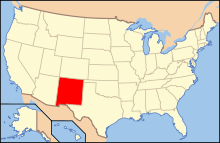
Paleontology in New Mexico refers to paleontological research occurring within or conducted by people from the U.S. state of New Mexico. The fossil record of New Mexico is exceptionally complete and spans almost the entire stratigraphic column.[1] More than 3,300 different kinds of fossil organisms have been found in the state. More than 700 of these were new to science and more than 100 of those were type species for new genera.[2] During the early Paleozoic, southern and western New Mexico were submerged by a warm shallow sea that would come to be home to creatures including brachiopods, bryozoans, cartilaginous fishes, corals, graptolites, nautiloids, placoderms, and trilobites. During the Ordovician the state was home to algal reefs up to 300 feet high. During the Carboniferous, a richly vegetated island chain emerged from the local sea. Coral reefs formed in the state's seas while terrestrial regions of the state dried and were home to sand dunes. Local wildlife included Edaphosaurus, Ophiacodon, and Sphenacodon.
Triassic New Mexico had a seasonal climate and was home to a richly vegetated flood plain where early dinosaurs such as Coelophysis lived. During the Jurassic New Mexico had a relatively dry climate and was home to dinosaurs such as Allosaurus, Stegosaurus, and the huge long-necked sauropods. Seawater covered eastern New Mexico during the Cretaceous, while on land dinosaurs, including tyrannosaurs, maintained their dominance. Early in the Cenozoic New Mexico was swampy, but gradually the local climate cooled. Local wildlife included creatures such as amblypods, carnivorans, condylarths, the 7-foot tall flightless bird Diatryma, three-toed horses, marsupials, multituberculates, and taeniodonts. Cooler climates eventually ushered in the Ice Age, when the state was home to mastodons.
Local Native Americans devised myths to explain local fossil bones and petrified wood. New Mexico's fossils first came to the attention of formally trained scientists by the mid-19th century. Major finds in the state include Coryphodon, a mummy of the ground sloth Nothrotherium, Triassic Coelophysis bonebeds, bonebeds of Triassic amphibians and the gigantic sauropod formerly known as Seismosaurus. The Triassic dinosaur Coelophysis bauri is the New Mexico state fossil.
